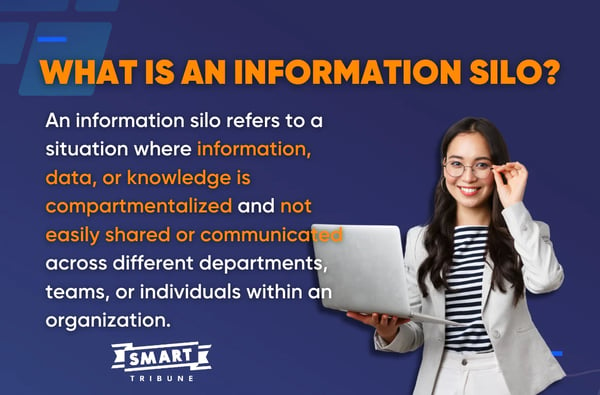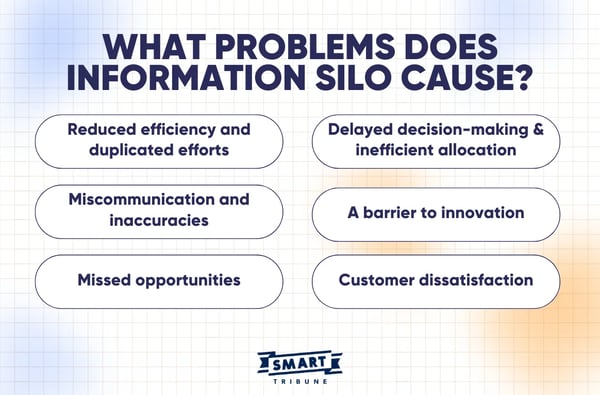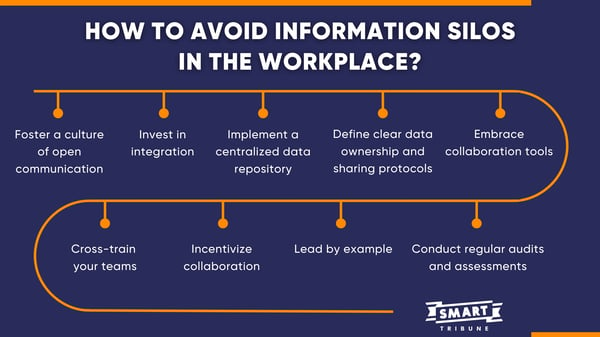In the ever-evolving landscape of today's organizations, information is the currency of progress. Yet, information silo may stand as formidable barriers to productivity and innovation. Understanding that your business is struggling, in this article, we will walk you through everything related to information silo:
- Definition of information silo,
- The causes of information silos,
- Its negative effects,
- Techniques to avoid information silo at work,
- Frequently asked questions about information silo.
Let's get cracking!
What is An Information Silo in the Workplace?
In the workplace, an information silo refers to a situation where information, data, or knowledge is compartmentalized and not easily shared or communicated across different departments, teams, or individuals within an organization. 
What Causes Information Silo?
Information silos in the workplace can have various causes and consequences. Let's zoom in on the details.

- Departmental silos: One common form of information silo occurs when different departments within an organization keep their data and information isolated from one another. Each department operates independently with its own set of tools, systems, and data, making it challenging to share information and collaborate effectively.
- Lack of integration: When various software systems and tools used in different parts of the organization are not integrated, it can lead to information silos. Incompatibility between systems prevents the seamless exchange of data.
- Communication barriers: In workplaces with poor communication practices or a lack of effective channels for sharing information, silos can form. This may be due to a lack of clear communication protocols or cultural factors that discourage sharing.
- Geographic or remote teams: Organizations with multiple geographic locations or remote teams may face information silos. Geographic or time zone differences can make it more difficult to share information and collaborate effectively.
- Knowledge hoarding: Individuals or small groups within an organization may hoard knowledge or information, intentionally or unintentionally, rather than sharing it with colleagues. This can be driven by concerns about job security, competition, or simply a lack of awareness about the importance of sharing knowledge.
Find out how to successfully develop a knowledge management strategy to fix information silo.
What Problems Does Information Silo Cause in Organizations?
Information may seem harmless at first glance, but it can have far-reaching consequences for businesses and institutions alike.
Reduced efficiency and duplicated efforts
One of the most insidious effects of information silos is reduced efficiency. When different departments or teams operate in isolation, they often duplicate efforts.
Valuable resources are squandered on tasks that could have been streamlined if information flowed freely. Time and money are wasted, hampering overall productivity.
Learn more about how an internal knowledge base boosts employees' efficiency and productivity.
Miscommunication and inaccuracies
Another shadow cast by information silos is miscommunication.
With vital data hidden away, various sections of an organization may operate with incomplete or outdated information. The result? Errors, misunderstandings, and confusion that can ripple through the organization.
Furthermore, when data is scattered and fragmented, inconsistencies and inaccuracies can creep in, leading to decisions based on flawed information.
Missed opportunities
In an era where personalization and customer-centric approaches reign supreme, information silos are especially damaging. They can cause missed opportunities for cross-selling and upselling, as well as leave customers' needs unaddressed.
The inability to access a complete view of customer data stifles the ability to tailor products or services to their preferences, potentially resulting in lost revenue.
Discover 5 ways to satisfy customer needs.
Delayed decision-making and inefficient resource allocation
Effective decision-making relies on timely access to comprehensive data. Information silos hinder this by creating obstacles to obtaining the necessary insights. As a result, decision-makers are often left waiting for data to be gathered and consolidated, bringing about delays in crucial strategic moves.
Additionally, the inability to share resource information across departments can lead to the inefficient allocation of resources, which may exacerbate budgetary constraints.
A barrier to innovation
Innovation thrives on collaboration and the exchange of ideas and knowledge. Information silos, however, can impede this collaborative spirit.
Different teams within an organization may remain unaware of valuable insights present in other departments, stifling creativity and inhibiting the organization's ability to stay competitive in a rapidly changing world.
Customer dissatisfaction
Customers interact with various parts of an organization, and when those interactions yield inconsistent or incomplete information, dissatisfaction ensues.
Poor customer experiences can have long-lasting negative impacts on a business's reputation and success.
Explore the significance of customer experience (CX) and tactics to improve it.
Apparently, information silos pose a significant threat to the vitality of organizations. While their consequences may not always be immediately noticeable, they undermine efficiency, disrupt communication, and hinder progress. To thrive in the modern business environment, organizations must recognize the importance of breaking down these barriers and fostering an environment of collaboration and information sharing.
How to Avoid Information Silos?
In a world where the pace of change is accelerating, organizations must be agile, adaptable, and equipped with the most up-to-date information to flourish. Yet, many still struggle with a hidden menace that hinders growth and innovation—information silos. But fear not, for we're here to guide you on how to avoid these silos and create a culture of seamless information flow within your workplace. 
Foster a culture of open communication
Creating an environment where communication flows freely is the first step in banishing information silos.
Leaders should encourage teams to share insights, challenges, and successes across departments. Promoting regular meetings, brainstorming sessions, and cross-functional collaboration will help break down communication barriers.
Invest in integration
In the age of technology, integrated systems are your allies against information silos.
When different departments use interconnected software and tools, data can move seamlessly from one corner of your organization to another. Knowledge base software helps streamline your processes and reduce redundancy.
Smart Knowledge is a powerful knowledge base software that streamlines managing and distributing knowledge within your organization. With the great investment in AI, Smart Tribune assists employees to effortlessly search for needed information within clicks, and in the meantime, helps knowledge managers quickly audit content to close knowledge gaps.
Implement a centralized data repository
A single source of truth can be your organization's salvation. By establishing a central data repository, such as Smart Dashboard, you provide all teams with access to accurate, up-to-date information. This not only facilitates decision-making but also ensures consistency and reliability across your operations.
Define clear data ownership and sharing protocols
One of the main culprits behind information silos is uncertainty about data ownership and sharing protocols. Leaders are supposed to clearly define who is responsible for various types of data and establish protocols for how information should be shared and accessed. This will eliminate confusion and minimize the risk of silos forming.
Embrace collaboration tools
Collaboration tools, such as project management platforms and communication software, can be your allies in the fight against information silos. These tools foster real-time communication and document sharing, enabling teams to transfer implicit knowledge, improve knowledge retention and work together efficiently, regardless of their physical location.
Over 150 big brands have deployed the knowledge management solution of Smart Tribune to tackle information silos. Now, it's your turn to try no.1 French knowledge base software to maximize your team's productivity.
Cross-train your teams
Cross-training employees can help ensure that they have a broader understanding of the organization's operations. When employees have a working knowledge of other departments, they are better equipped to communicate and collaborate effectively.
Conduct regular audits and assessments
To effectively implement audits and assessments, knowledge managers should:
- Periodically assess the organization's information-sharing practices.
- Identify areas where information silos may be forming and take corrective action.
Regular audits can help you stay vigilant and proactive in your efforts to avoid silos.
Find out how to develop a knowledge management framework that benefits your business.
Lead by example
Leaders play a critical role in setting the tone for the organization. They are expected to lead by example and demonstrate the importance of open communication, collaboration, and knowledge sharing. When leaders embrace these values, it encourages employees at all levels to follow suit.
Leaders and managers can dig deeper into guides, tips and templates for effective knowledge base articles.
Incentivize collaboration
Leaders should consider introducing incentives or rewards for teams and individuals who actively participate in cross-functional collaboration and knowledge sharing. Recognition for those who go the extra mile can be a powerful motivator.
Uncover the fundamentals of knowledge management:
- Handbook on the basics of knowledge transfer.
- The basics of creating and managing a knowledge base.
- How to use a knowledge base for financial compliance?
In a world where information is king, breaking down information silos is not just a luxury; it's a necessity. Organizations that embrace a culture of open communication, invest in technology, and encourage knowledge sharing are better equipped to navigate the complexities of the modern workplace. By following these aforementioned steps, you can ensure that your organization is well on its way to avoiding the pitfalls of information silos and achieving a brighter, more collaborative future.
FAQs about Information Silos
1. What are information silos?
Information silos are isolated or separated compartments where data, knowledge, or information is not effectively shared or communicated within an organization, leading to problems such as reduced efficiency, miscommunication, and missed opportunities for collaboration and innovation.
2. What is an example of an information silo?
An example of an information silo is when a marketing department within a company maintains its own customer data and analytics, and this data is not readily accessible or shared with other departments, such as sales or customer service. This isolation of customer information can hinder cross-departmental collaboration and result in missed opportunities for improving customer relationships.
3. How to avoid an information silo?
To avoid information silos, managers should promote open communication, invest in integrated systems, establish a centralized data repository, define clear data ownership and sharing protocols, and encourage knowledge sharing among employees.
Key Takeaways from Information Silo
In the digital age, where the flow of information is paramount, conquering the challenge of information silo stands as a top priority for organizations.
Knowledge management tool, such as Smart Knowledge, is a beacon of hope in the fight against information silos. Our knowledge base solution provides a centralized platform where data, knowledge, and insights can be accessed and shared with ease. With intuitive interfaces, integration of AI, powerful search capabilities, and efficient categorization, Smart Tribune empowers organizations to harness their collective wisdom, ultimately boosting efficiency and productivity.
It's been a long journey to discover the core of the information silo, hope you will quickly fix it and thrive. Should you have any further inquiries or give Smart Knowledge a whirl, drop us a line for assistance.


